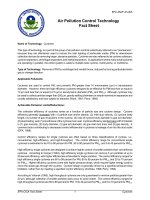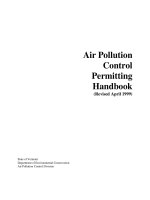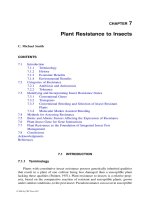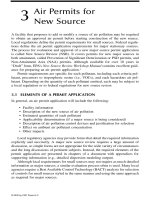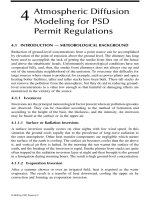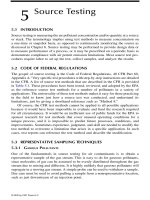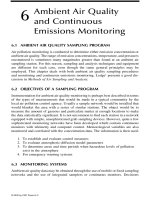AIR POLLUTION CONTROL TECHNOLOGY HANDBOOK - CHAPTER 7 pps
Bạn đang xem bản rút gọn của tài liệu. Xem và tải ngay bản đầy đủ của tài liệu tại đây (90.78 KB, 5 trang )
Cost Estimating
Cost is a basic and crucial decision-making factor in the selection of air-pollution
control equipment. Evaluating costs can be straightforward, as long as there is an
understanding as to the objective of the analysis and an appreciation of the time
value of money. The classic cost trade-off is between capital and operating costs.
This chapter is designed to assist the practicing engineer with cost engineering
techniques for estimating capital cost of equipment and for determining the annu-
alized cost of operating air-pollution control systems, such as required for the cost
analysis portion of a BACT analysis. It is not intended to cover detailed cost
accounting methods that include different types of depreciation and taxes.
7.1 TIME VALUE OF MONEY
Because of interest and inflation, a dollar in U.S. currency today will be worth more
than a dollar in the future. Right off the bat we must distinguish between the “real”
interest rate, which does not include inflation, and the “nominal” interest rate, which
includes inflation. The “real” or “constant” dollar cost analysis considers the return
on investment as profit. This type of analysis frequently is used by engineers because
it is straightforward, easy to use, and easy to understand. Annual operating and labor
costs of $100,000 this year will remain at $100,000 per year in 10 years. To be clear,
the analysis is stated to be in “year 2000 dollars.”
Conversely, inflation reduces the value or buying power of the currency with
time. $100,000 worth of materials and labor this year will require more money in
10 years. The real and nominal interest rates are related by:
(7.1)
where
i
n
= nominal interest rate
i = real interest rate
r = annual inflation rate
Financial decisions that include the effect of income taxes use the nominal
interest rate because both depreciation deductions and taxes are figured on the basis
of nominal dollars.
7.1.1 A
NNUALIZED
C
APITAL
C
OST
The key to annualizing capital cost in real, pre-tax dollars is to calculate the capital
recovery factor (CRF).
7
111+
()
=+
()
+
()
iir
n
9588ch07 frame Page 85 Wednesday, September 5, 2001 9:47 PM
© 2002 by CRC Press LLC
(7.2)
where
CFR = capital recovery factor
i = real pretax marginal rate of return on private investment
n = economic life of the equipment for the analysis
The product of the capital recovery factor and the capital cost, or investment (P),
is the annualized capital recovery cost (CRC).
(7.3)
7.1.2 E
SCALATION
F
ACTORS
Several cost indexes are available that reflect current costs to a baseline cost. Exam-
ples include the Marshall & Swift Equipment Cost Index and the Chemical Engi-
neering Plant Cost Index. Specific to the air-pollution control industry is the Vatavuk
Air Pollution Control Cost Index.
1
An index is used to convert a known cost at one
point in time to an escalated cost at another point in time. The conversion is simply
the ratio of the index values for the two points in time.
Indexes are useful for the time periods covered by the index. The Vatavuk Air
Pollution Control Cost Index begins in the first quarter of 1994 with a baseline value
of 100. Cost data obtained prior to 1994 cannot be escalated using the Vatavuk index,
but the Marshall & Swift Equipment Cost Index can be used from a baseline date
of 1926.
Vatavuk Air Pollution Control Cost Indexes are provided for specific air-pollu-
tion control devices, including carbon adsorbers, catalytic incinerators, electrostatic
precipitators, fabric filters, flares, gas absorbers, mechanical collectors, refrigeration
systems, regenerative thermal oxidizers, and wet scrubbers. Updated values of the
indexes are published in each biweekly issue of
Chemical Engineering
. Annual
values for these indexes are provided in Table 7.1
7.2 TYPES OF COST ESTIMATES
The accuracy of the project cost estimate and the effort required to calculate it must
be appropriate for the decision being made. The American Association of Cost
Engineers lists
2
three types of estimates:
• Order of magnitude
• Budget
• Definitive
The “order-of-magnitude” cost estimate uses rules-of-thumb based on prior expe-
rience. The only data requirement is the system capacity. Frequently an exponential
CRF
ii
i
n
n
=
+
()
+
()
−
1
11
CRC CRF P=×
9588ch07 frame Page 86 Wednesday, September 5, 2001 9:47 PM
© 2002 by CRC Press LLC
factor of 0.6 is used to factor the capacity of large facilities.
3
The accuracy of order-
of-magnitude is supposed to be +50% to –30% rather than a factor of 10 as the
name implies. However, there is little control of accuracy, and this approach may
amount to a best-guess with a very high level of inaccuracy.
Budget estimates typically have an accuracy of +30% to –15%. These estimates
require knowledge of the site, flow sheet, equipment, and buildings. Also, rough
specifications for items such as insulation and instrumentation are needed.
Definitive cost estimates, accurate to within ±20%, require complete plot plans,
piping and instrument diagrams, specifications, and site surveys, as well as vendor
bids for major equipment.
Perry’s Chemical Engineers’ Handbook describes five levels of detail and accu-
racy for cost estimates:
4
• Order-of-magnitude
• Study (factored) with an accuracy of ±30%
• Preliminary (budget authorization) with an accuracy of ±20%
• Definitive (project control) with an accuracy of ±10%
• Detailed (firm or contractors) with an accuracy of ±5%
Note that these definitions for level of accuracy are not consistent between the two
sources, which can easily lead to confusion when one simply refers to a descriptor
such as a “budget” or “definitive” estimate. Even describing an estimate by its desired
accuracy can be misleading. To achieve a desired level of accuracy, it is best to
define the resources and approach that are to be used to develop the cost estimate.
Air-pollution control equipment cost estimating at the “study” level with ±30%
accuracy has received a great deal of attention because of the requirement to deter-
mine the “cost effectiveness” for best available control technology (BACT) analyses.
To make a good study estimate, the following resources
4,5
should be used:
TABLE 7.1
Vatavuk Annual Average Air-Pollution Control Cost Index
1
1994 1995 1996 1997 1998 1999 2000
a
Carbon adsorbers 101.2 110.7 106.4 104.7 103.6 100.8 107.8
Catalytic incinerators 102.0 107.1 107.0 107.7 106.5 102.9 113.0
Electrostatic precipitators 102.8 108.2 108.0 108.8 109.2 101.2 101.0
Fabric filters 100.5 102.7 104.5 106.2 109.5 111.7 113.2
Flares 100.5 107.5 104.9 105.8 103.6 99.4 104.5
Gas absorbers 100.8 105.6 107.8 107.6 109.7 110.9 112.8
Mechanical collectors 100.3 103.0 103.3 103.9 111.0 119.6 121.8
Refrigeration systems 100.5 103.0 104.4 106.1 107.6 105.7 106.1
Regenerative thermal oxidizers 101.4 104.4 106.3 107.9 108.9 108.1 109.1
Thermal incinerators 101.3 105.9 108.2 109.4 110.5 108.1 108.0
Wet scrubbers 101.3 112.5 109.8 109.0 109.7 108.8 113.7
a
Preliminary.
9588ch07 frame Page 87 Wednesday, September 5, 2001 9:47 PM
© 2002 by CRC Press LLC
• Location of the source within the plant
• Preliminary process flow sheet
• Preliminary sizing and material specifications for major equipment
• Approximate sizes and types of construction of any buildings required to
house the control system
• Rough estimates of utility requirements (e.g., steam, water, electricity,
etc.)
7.3 AIR POLLUTION CONTROL EQUIPMENT COST
7.3.1 OAQPS C
ONTROL
C
OST
M
ANUAL
To assist permit applicants and reviewing agencies, and to bring some semblance
of consistency to the permit applications, the EPA has published guidelines
5
for
estimating the cost of various equipment including thermal and catalytic incinerators,
carbon adsorbers, fabric filters, electrostatic precipitators, flares, refrigerated con-
densers, gas absorbers, and hoods, ductwork, and stacks. The manual provides a
good overview of cost estimating methodology, descriptions of the control equipment
and fundamentals of operation, cost correlations based on size and materials, and
factors for operating costs.
7.3.2 O
THER
C
OST
-E
STIMATING
R
ESOURCES
The OAQPS Control Cost Manual does not discuss all air-pollution control devices,
nor does it cover large, complex air-pollution control systems such as flue gas
desulfurization systems. Traditional engineering cost estimating approaches may be
applied in these cases. The design engineer produces a bill of materials including
individual equipment items (vessels, pumps, blowers, exchangers, etc.). Using the
equipment size and weight and material of construction, a cost-estimate can be
produced. Common sources of equipment cost estimates include Perry’s
Chemical
Engineers’ Handbook
4
and Richardson’s
Process Plant Construction Estimating
Standards
.
6
Additional material has been published by Vatavuk,
7
who is also the
primary author and editor of the OAQPS Control Cost Manual. A large amount of
detailed cost information on utility flue gas desulfurization systems has been spon-
sored and published by the Electric Power Research Institute.
8,9
REFERENCES
1. Vatavuk, W. M.,
Escalation Indexes for Air Pollution Control Costs
, U.S. Environ-
mental Protection Agency, EPA-452/R-95-006, Research Triangle Park, NC, 1995.
2. Humphreys, K. K. and Katell, S.,
Basic Cost Engineering
, Marcel Dekker, New York,
1981, 108.
3. Peters, M. S. and Timmerhaus, K. D.,
Plant Design and Economics for Chemical
Engineers,
3
rd
ed., McGraw-Hill, New York, 1980, 183.
4. Perry, R. H., Green, D. W, and Maloney, J. O.,
Perry’s Chemical Engineers’ Hand-
book,
7
th
ed., McGraw-Hill, New York, 1997, 9–64.
9588ch07 frame Page 88 Wednesday, September 5, 2001 9:47 PM
© 2002 by CRC Press LLC
5.
OAQPS Control Cost Manual
, 5th ed., U.S. Environmental Protection Agency, EPA
453/B-96-001, Research Triangle Park, NC, 1996.
6.
Process Plant Construction Estimating Standards
, Richardson Engineering Services,
Inc., San Marcos, CA, 2001.
7. Vatavuk, W. M.,
Estimating Costs of Air Pollution Control
, Lewis Publishers, Chelsea,
MI, 1990.
8. Keeth, R. et al.,
Economic Evaluation of FGD Systems,
GS-7193, Vol. 1 and 2,
Electric Power Research Institute, Palo Alto, CA, 1991.
9. Keeth, R. J., Ireland, P. A., and Radcliffe, P. T., Economic evaluations of 28 FGD
processes, presented at 1991 EPRI/EPA/DOE SO
2
Control Symp., Washington, D.C.,
Dec. 3–6, 1991.
9588ch07 frame Page 89 Wednesday, September 5, 2001 9:47 PM
© 2002 by CRC Press LLC
